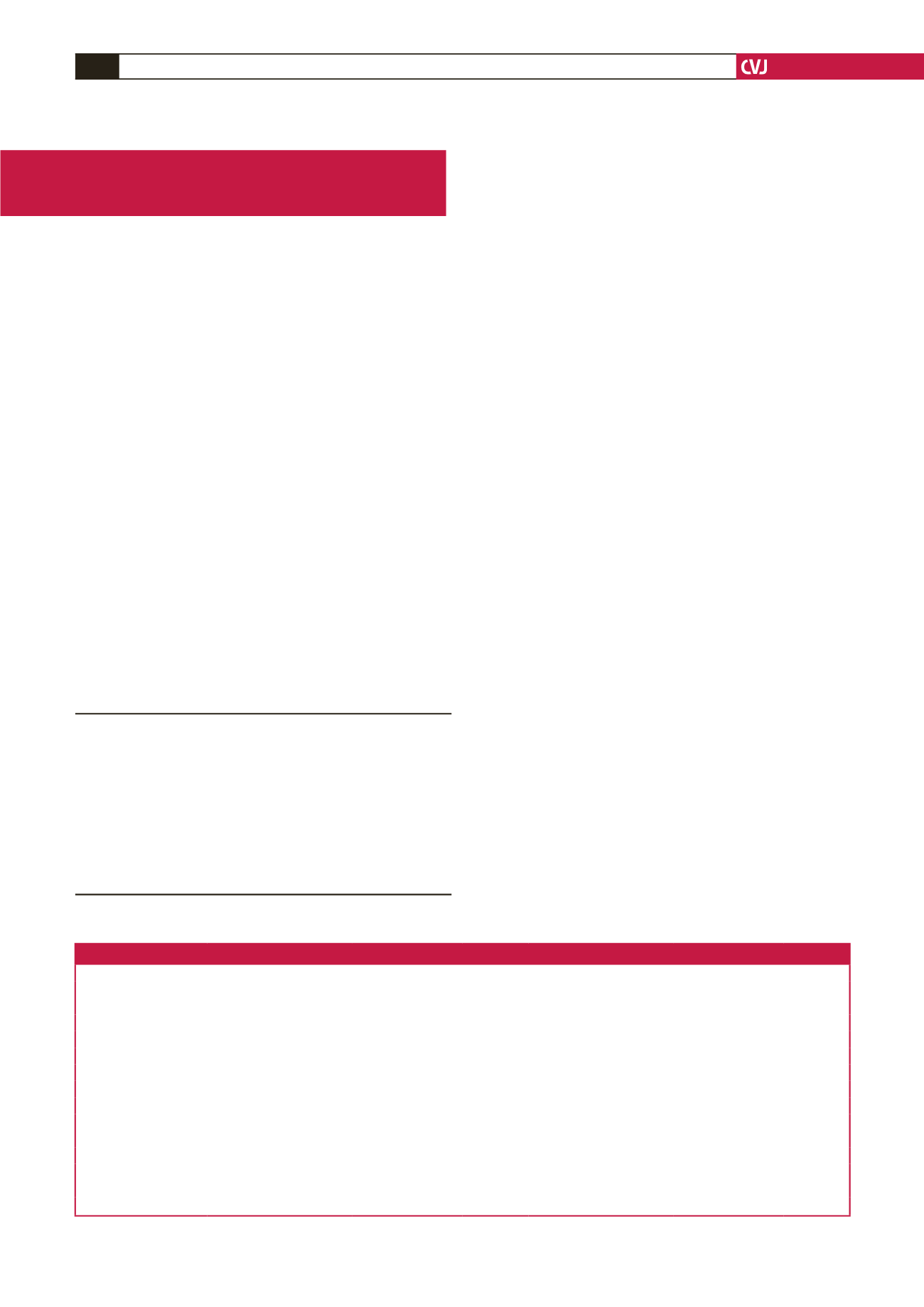

CARDIOVASCULAR JOURNAL OF AFRICA • Volume 29, No 4, July/August 2018
260
AFRICA
Letters to the Editor
Multivessel disease in STEMI patients: a perspective
from limited-resource settings
Ahmed Ali Ahmed Suliman, Nauman Naseer, Bernard Gersh
Keywords:
debate, Africa STEMI Live, multivessel disease,
STEMI, limited-resource setting, infarct-related artery, non-
infarct-related artery, complete revascularisation
Cardiovasc J Afr
2018;
29
: 260–261
www.cvja.co.zaDOI: 10.5830/CVJA-2018-034
During the Africa STEMI Live meeting held in Nairobi from
26 to 28 of April 2018, the Great Debate session was on how to
approach non-infarct-related (N-IRA) disease in patients who
present with STEMI and multivessel disease (MVD) in a limited-
resource setting.
Dr Nauman Naseer, professor of cardiology at Akhtar Saeed
Medical College and chief of cardiology at Bahria International
Hospital, was the protagonist for complete revascularisation of
significant N-IRA disease and Dr Ahmed Suliman, associate
professor of cardiology at the University of Khartoum and
cardiologist at the National Cardiothoracic Centre in Khartoum,
Sudan, argued for infarct artery (IRA)-only revascularisation.
The session was moderated by Dr Bernard Gersh, professor of
medicine and consultant in the Department of Cardiovascular
Diseases at the Mayo Clinic, College of Medicine, USA.
Both debaters agreed that the main focus is to achieve
successful revascularisation of the IRA and the restoration
of TIMI 3 flow but cited the evidence demonstrating that
concomitant multivessel disease is frequently encountered in
ST-elevation myocardial infarction (STEMI) patients and is
associated with poorer outcomes than those who present with
IRA disease only.
Prof Naseer explained the four possible strategies to deal with
N-IRA significant disease: intervention within the setting of
primary percutaneous intervention; a staged procedure during
the index admission and before discharge; a staged procedure
after discharge; or treating the N-IRA disease as per stable angina
pectoris guidelines. Prof Naseer supported full revascularisation
preferably during the same hospital admission, an approach
endorsed by the ESC guidelines (class IIa indication).
1
His main
arguments were:
•
Several randomised trials demonstrated the superiority of
complete revascularisation of N-IRA versus IRA only. The
largest four trials were PRAMI,
2
CvLPRIT,
3
DANAMI-3
PriMULTI
4
and COMPARE-ACUTE
5
trial (Table 1). Benefit
was driven primarily by the need for repeat revascularisation
with only a trend towards a reduction in hard end-points.
University of Khartoum, Khartoum, Sudan
Ahmed Ali Ahmed Suliman, MB BS, FACP, FESC, sulima01@
hotmail.comDepartment of Cardiology, Akhtar Saeed Medical College,
Lahore, Pakistan
Nauman Naseer, MD, FACC, FSCAI, FACP
Department of Medicine, Mayo Clinic, College of Medicine,
Rochester, Minnesota, USA
Bernard Gersh, MB ChB, DPhil
Table 1. Summary of outcomes of major trials comparing complete revascularisation versus IRA-only
Study
Primary outcome
HR ( 95% CI)
p-
value
Secondary outcomes
HR ( 95% CI)
p-
value
PRAMI
CV death, non-fatal MI and
refractory angina
0.35 (0.21–0.58)
< 0.001
CV death
0.34 (0.11–1.08)
0.07
Non-fatal MI
0.32 (0.13–0.75)
0.009
Repeat revascularisation
0.30 ( 0.17–0.56)
< 0.001
CvLRIT
Death, non-fatal MI,
heart failure, repeat
revascularisation
0.45 (0.24–0.48)
0.009
Death
0.32 (0.06–1.60)
0.14
Non-fatal MI
0.48 (0.09–2.62)
0.39
Heart failure
0.43 (0.13–1.39)
0.14
Repeat revascularisation
0.55 (0.22–1.39)
0.2
DANAMI-3 PriMULTI
Death, non-fatal MI and
repeat revascularisation
0.56 (0.38–0.83)
0.004
Death
1.4 (0.63–3·0)
0.43
Non-fatal MI
0.94 (0.47–1.9)
0.87
Repeat revascularisation
0.31 (0.18–0.53)
< 0.001
COMPARE-ACUTE
Death, non-fatal MI, repeat
revascularisation, CVA
0.35 (0.22–0.55)
< 0.001
Death
0.8 (0.25–2.56)
0.7
Non-fatal MI
0.5 (0.22–1.13)
0.1
Repeat Revascularisation
0.32 (0.20–0.54)
< 0.001
HR = hazard ratio; CI = confidence interval; CV = cardiovascular; MI = myocardial infarction.

















